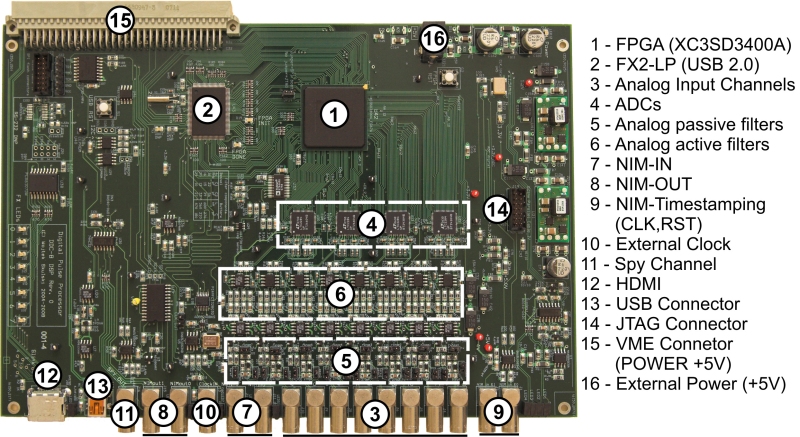DDC-8DSP
|
Overview:
|
The eight-channel digital pulse
processors DDC-8DSP designed by Wojtek Skulski is yet another substantial upgrade.
Since the 500k gate FPGA on DDC-8LUX was utilized up to ~97% (VHDL code was
optimized) it was time to make the step towards an FPGA with a BGA
footprint which offers much more resources for incorporating
growing demands. The chosen Xilinx Spartan DSP FPGA yields a seven (7)
fold increase in overall resources. Besides obvious
advantages like number of gates (3400k) and memory (283kB), one of the
very promising upgrades is the 126 multiply-accumulate blocks
which further extend the on-FPGA digital signal processing
possibilities. The ability of the board to use 14bit ADCs sampling at
125MHz makes the board a likely candidate for a DAQ board.
The
DDC-8DSP board has the capability of running on an external clock, which
makes it useful in applications where overall
time synchronization is critical. Additionally the clock distribution
chain on the board was redesigned to bring down the clock jitter below
10ps making the board attractive for timing applications.
|
---------------------------------------------------------------------------------------------------------------------------------------
|
The board:
|
|
|
|
Main parameters:
|
|
DDC-8DSP |
| FPGA |
XC3SD3400A |
| Analog to Digital Converter |
14bit@up
to 125MHz |
| Number of channels |
8 |
| Block Memory |
283kB
(six times more than DDC-8LUX) |
| Buffer length per channel |
potentially
~6100 samples (+ zero suppression can be implemented) |
| Additional features |
126
Multiply-accumulate blocks
HDMI
high speed connector
Timestamping NIMs (CLK,RST) |
|
Potential new firmware features:
|
- Digital channel sum
- Digital gain matching between the channels
- Pulse width measurements in real time
- DAQ capabilities
|
| --------------------------------------------------------------------------------------------------------------------------------------- |
Real application:
|
LUX Trigger
|
Eryk
Druszkiewicz, Frank Wolfs
|
| The
firmware from DDC-8LUX is being ported onto the new BGA FPGA with
additional new features. |
|
|
